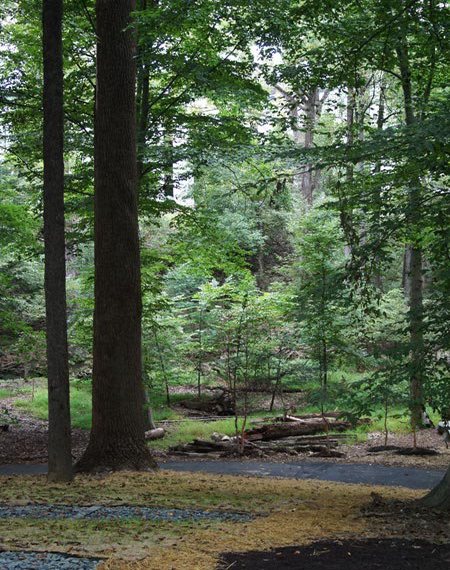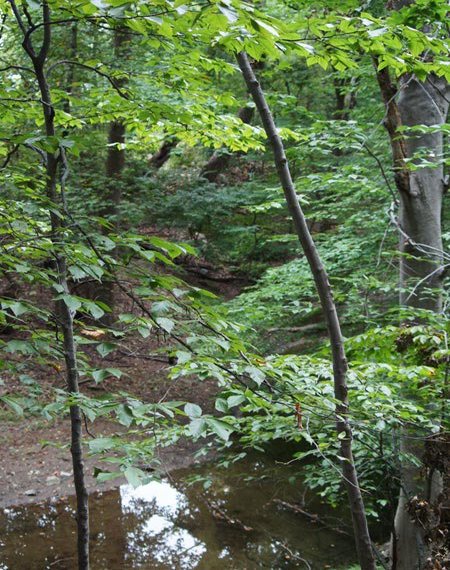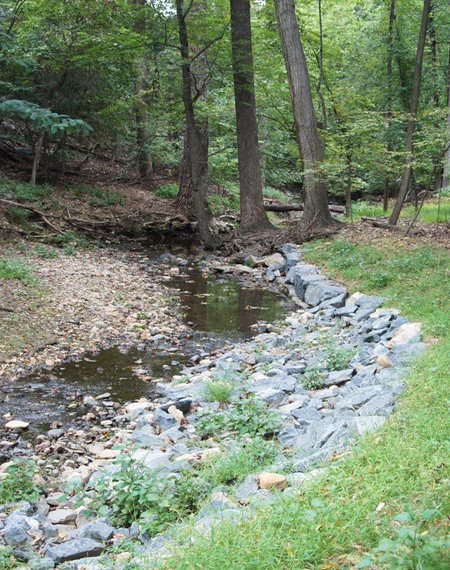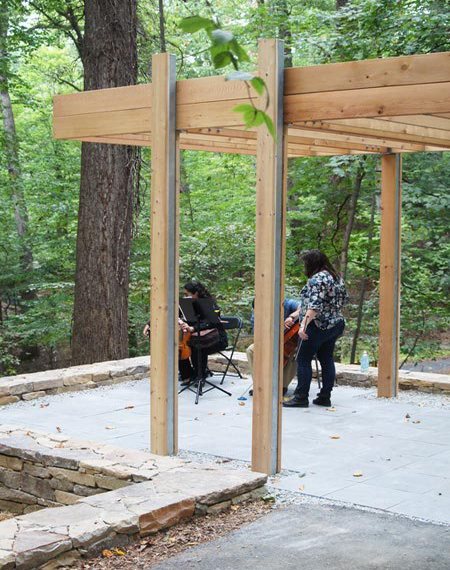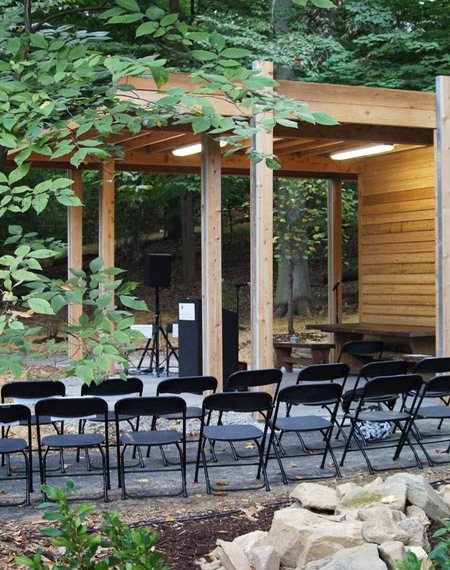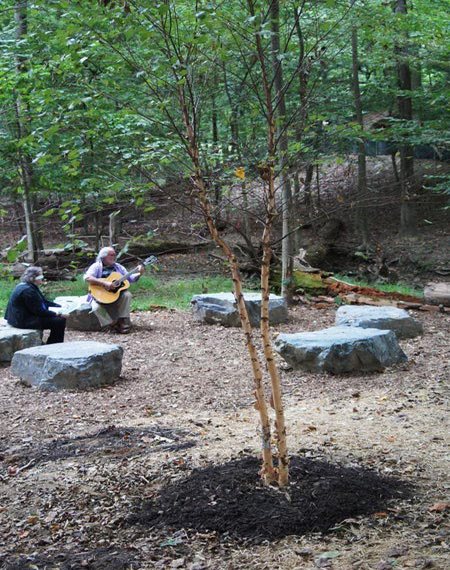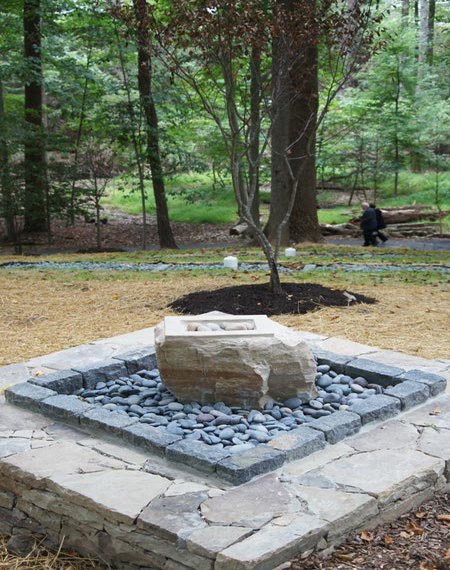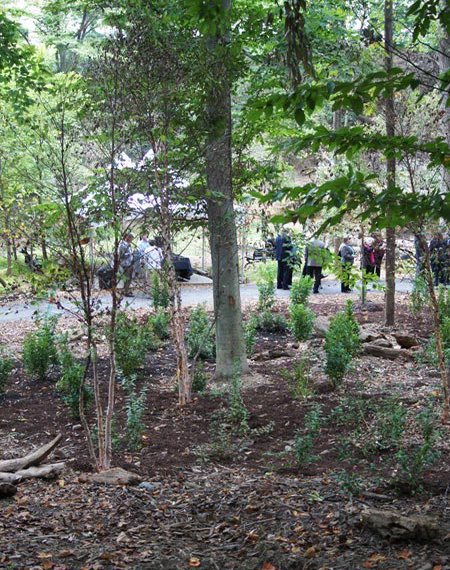The Green Road / Jared Green
Can spending time in nature help heal veterans with post-traumatic stress disorder (PTSD) and traumatic brain injury? As suicides from PTSD sufferers only increase, the Institute for Integrative Health (TIIH) seeks out answers to this important question through their new Green Road project, which just opened at the Naval Support Activity Bethesda, home of Walter Reed Military Medical Center, in Maryland.
In the middle of the vast medical and university campus, the Green Road takes patients, nurses, and staff down a zig-zaging path to a healing woodland garden, a beautiful 2-acre valley, which used to be a golf course, but now feels wild. The restored forest and stream are at the heart of the experience.
Restored stream / Jared Green
Restored stream bank / Jared Green
And these restored places are the source of the vista seen from two new, open-air cedar and steel pavilions.
Pavilion / Jared Green
Pavilion / Jared Green
The landscape was designed and built by a team led by CDM Smith, including landscape architect Jack Sullivan, FASLA, and his students at the University of Maryland.
The idea for the project came from retired U.S. Navy neurologist Frederick Foote, M.D., now a scholar at TIIH. His vision was to bring back an ancient idea: using nature to heal. As Foote explained, four different teams of scientists -- from the Arizona Center for Integrative Medicine, University of Tucson; Benson-Henry Institute of the Massachusetts General Hospital; Consortium for Health and Military Performance, Uniformed Services University of the Health Sciences; and National Institute of Health Clinical Center, Pain, and Palliative Care Services -- will undertake in-depth studies in the Green Road to "isolate where nature has the most effect." Some $1.1 million in research will be conducted, all made by possible by the smart and impactful TKF Foundation, which provided some $1.1 million towards the $3.2 million project.
Walking down the path, one of the first things visitors notice are the massive logs strewn through the garden. At first, I thought their intention was ecological: to regenerate the soil and create habitat for small creatures. But, as Foote explained, the dead trees are also symbols of fallen soldiers. Often, soldiers experience PTSD because they have lost a close friend in battle. The logs are opportunities for those suffering with PTSD to remember those they've lost in a more gentle, natural way and connect death with the positive cycle of regeneration.
Fallen trees / Jared Green
Fallen trees / Jared Green
Throughout, the garden brings in elements that veterans, both with PTSD and without, identified were important to them. As Sullivan explained at the opening ceremony, design charrettes were conducted with 30 veterans to figure out how the natural beauty of the stream and forest could be enhanced to create a healing effect. "They wanted both a solitary place where they could get away and find solace nature, and a special place to meet others to commemorate those who had fallen, a place to get together with family and comrades."
Stone Council Circle / Jared Green
The landscape restoration was extensive. Invasive plants were removed and 58 new trees were planted, including river birch, pin oaks, and magnolias. Summersweet shrubs, which will bloom in summer, were planted in abundance. Still, the restored stream, done by Angler Environmental, is perhaps the major attraction. One bank was stabilized, trees were cut back, and the other eroding bank will be restored next.
Foote explained that "the Green Road features stone, water, trees, and animals. Through design, they are paired in new ways. We believe these paired natural systems can help heal PTSD."
Stone fountain / Jared Green
Foote looks to nature for solutions, perhaps because he has spent decades witnessing the failings of modern medicine to solve PTSD in wounded warriors. "We have been trying to heal people one organ at a time with pills and surgery." But the problem is that PTSD "doesn't respond to those treatments, so we need to try holistic approaches."
That move towards holistic medicine -- which the Greeks of ancient times and the Chinese of today still practice -- has been a slog. "Our cultural obsession with technology means we underestimate holistic therapy." Mainstream medical practitioners undervalue it, because, to date, it has been impossible to measure "whole body effects, mathematically." They can only measure with confidence that this treatment or that pill yields results on this or that organ.
Foote sees the future in creating proof of the benefits of holistic approaches: a set of "whole body metrics" that could be used to test and measure the effect of these treatments for PTSD and other disorders. Foote wants to apply many technologies and approaches to forge these new metrics: genomics, which would look at which genes are turned on during PTSD and what can turn then off; artificial intelligence-based textual analysis of patients' writings to categorize and diagnose their disorders; integrated biometrics of stress to measure physiological effects of suffering and also treatments; and big data analyses to find more accurate sub-groups for evaluation. Foote hopes the Green Road can help test these nascent "whole body metrics," at least for the metrics and potential treatments related to exposure to nature. "I hope this becomes the national laboratory for studying how humans interact with nature."
Humans and nature / Jared Green
His plan is that a group of 50 veterans, some suffering from PTSD and some not, will be studied in the Green Road. Their physiological response to the place will be measured in detail. "We could ask a group to spend an hour in the Green Road on a scavenger hunt, and then the next day, they could do the same on the streets and we could measure the differences in their responses."
While the Green Road is a major success, the only criticism is that it's hidden behind buildings and parking lots, and there is no signage to explain how to get there. It's a good 15 minute walk from the medical facilities. For patients, it's a destination, not a place to simply wander into. Walter Reed will need to further promote to ensure it's well-used by the people who need it. Asked whether Walter Reed will actually prescribe patient time there or conduct horticultural therapy sessions there, Foote seemed a bit pessimistic, pointing to limited budgets. "We need $2 million, $5 million to do everything." But he does see the Green Road hosting events and therapeutic exercises.
His grand vision for sometime in the near future is beautiful: sufferers of PTSD will wear a device like a Fitbit that would measure whole body responses and would let them know when they are getting stressed and alert them to go spend time in a park. A fascinating mix of ancient wisdom and new technologies.

